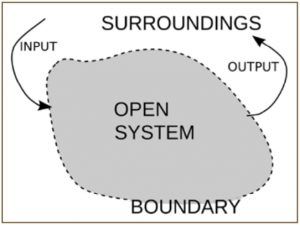A Working Family Governance Needs Family Narratives

Part I
In order to make family governance effective and sustainable, we need to work holistically with our neurological structure, starting with family narratives to embrace the past which informs the present and guides expectations about the future. Thus, family constitutions should be embedded in the family narratives.
NARRATIVE EMBEDDED – FAMILY GOVERNANCE
Business Families – Dynamic Social Systems

Business Families are dynamic, cybernetic social systems on a macroscopic level, made up of inter-dependent individuals (oscillators) who are sub-systems on a microscopic level. Left to their own device, oscillators self-organize and create non-linear patterns of relationships through synergistic and antagonistic forces corresponding to various attractors. Families are open, dissipative systems, prone to frictions and shocks.
Trajectories of social systems are non-linear, path-dependent and irreversible in time. They change through shocks, i.e. tipping points (bifurcations) that initiate phase transitions, caused by transient, transformational endogenous events like marriage, death, successions creating a VUCA1 environment, often in conjunction with exogenous shocks like economic crisis.
Transformation outcomes vary depending on the system’s ability to self-regulate and to resynchronize. Is the shock causing merely some variation or fluctuation, or is it a major impact on the system, which causes it to collapse?
Rigid systems have no freedom degrees, they reached the limits of self-regulation and collapse into chaos. Rigidity relates to the notion ‘this is the way we always have done it!’. In contrast, resilient systems have the optimal amount of freedom degrees, do not tip into chaos and change dynamically to become stronger as they learn from shocks. System resilience is essential for survival and can be created by introducing specific attractors that keep the system synchronized in VUCA situations.
Desynchronized: The Infamous 3rd Generation

The loss of socio-emotional and financial wealth of business families through system shocks is often observed, especially in the 3rd generation: the 1st generation builds the wealth, the 2nd generation is not really invested in, but they carry on regardless, trying to figure out how things work based on the information they snapped up. The following 3rd generation is mentally distanced, financially comfortable but do not really understand what is entailed to generate their financial well-being.
As they try to compensate for the void, they may behave uncooperatively, overspend, exhibit entitled behaviours, jeopardize the good reputation of the family, initiate conflicts and tip the system into chaos. On top, the business may have to deal with economic crisis, but the ‘traditional’ ways fail to work.
Thus, VUCA situations can desynchronize the system permanently!
Family governance introducing a common attractor synchronizes the system and can keep it synchronized. It reshapes behavioural patterns that promotes cooperation, responsibility and accountability, all attributes that are conducive to system resilience.
Family Constitutions

The traditional way to introduce common attractors are family constitutions. They manage expectations and synchronize the system through principles, rules and regulations. Effective synchronisation occurs, when all family members ‘mentally own’ the document and remember what they have undersigned. Anecdotal evidence suggests a low probability for family constitutions being mentally owned. The reasons are probably to be found in our neurology. To process, remember and apply the provisions laid out in the document, we need to employ our cognitive control network [CCN] and engage mainly our episodic memory, which holds structured information. But engaging the CCN and to manage episodic memories is laborious. Thus, family constitution become encyclopedic reference books and weak attractors.
Narrative Governance

The effects of narratives on social systems has been researched and shown to coordinate and synchronize our brains. The phenomenon is related to our mirror neuron system that underlies much of our social learning capacity. It is active in mutual understanding, imitation, empathy and promotes shared intentionality. Narratives are instrumental in the creation of our social identity and the oldest form of cultural transmission, so we are predisposed to process information delivered in the form of narratives! They evoke emotions and set emotional markers, which are essential for memory encoding and retrieval. Narratives are mostly held in our semantic memory section that holds unstructured information and is easily accessible in contrast to the episodic memory. Narratives are mainly processed in the default mode network [DMN] of our brains. It is active when we are not focusing on any specific task like in daydreaming and ex ante/ex post reflections e.g. about social processes.
Narratives are thus very strong attractors, the social glue of a social system that comes ‘naturally’ to us, unlike family constitutions.
Narratives Drive Decisions

Narratives can act as frames and memes. The framing effect epitomizes the power of linguistic subtlety in regulating decision-making, experiences, evaluation, preferences and persuasiveness of messages2. Based on the invariance principal, the preferential choice between two options should
be independent of their description. But we are predisposed to persistent decisional biases driven by frames. Experiments revealed that, choices between logically, two identical set of options depend on how the options are framed.3 This is confirmed by meta-studies: the framing condition was the top choice predictor, just followed by the expected economic pay-off4. Research in neuro-marketing substantiates these findings further: the subjective consumption experience is guided by external cues.
The beliefs of consumers about aspects of a product like quality, price, brand or packaging can influence the perception of the product itself (marketing placebo effect)5. Experiments with placebo pain killers showed, that probands stated preferences for the higher priced product, because it was perceived as more effective in killing pain, and neuroimaging studies with wine revealed preferences for the higher priced wine, as it elicited greater innervation of the reward circuitry compared to the lower price indication. The price is a cue, the anchor, a fragment of a narrative which triggers a script in the mind of the consumer. But these decisions are made outside conscious awareness. Social cognitions are also significantly influenced by narratives, especially when information is incomplete. Information gaps arise when primary contextual or social cues are absent or incongruent which poses a conflict situation. Narratives help to fill in the information gaps, linguistically and affectively. This reduces ambiguities in social decision-making processes6.
When we consider with whom we cooperate, we only have incomplete information about the contextual situation and the agent. We rely on a mix of the agents’ reputation (i.e. narratives told by others about the cooperative behaviour of the agent) and self-created narratives.
The influence of narratives is significant, but not eternal!
1. Volatility, Uncertainty, Complexity, Ambiguity.
2. Framing Effects: Behavioural Dynamics and Neural Basis, Xiao-Tian Wang, Lilin Rao, Hongming Zheng in Neuroeconomics, Springer.
3. Thinking Fast and Slow, Daniel Kahneman, Penguin.
4. Framing Effects: Behavioural Dynamics and Neural Basis, Xiao-Tian Wang, Lilli Rao, Hongming Zheng in Neuro Economics, Springer.
5. Consumer Neuroscience and Neuromarketing, Bernd Weber in Neuroeconomics, Springer.










